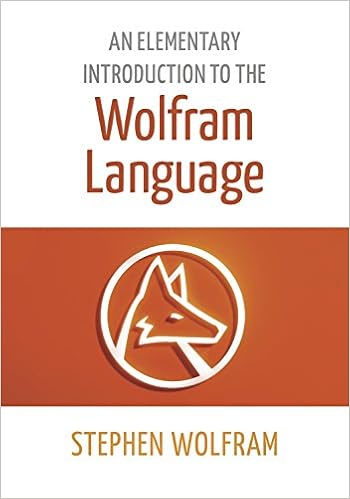
It was the Fall of 1988. I was a freshman at the University of Arizona. One of my classes was honors calculus. My professor, whose name is long forgotten, included in the course a new computer program called Mathematica. I remember, both because it was interesting and new and because it required me to purchase an additional book for the course. The book had a black cover, white text, and a colorful image that I can’t quite recall.
The author of that program and book was Stephen Wolfram, the same person who has written An Elementary Introduction to the Wolfram Language and the language that the book introduces. It is interesting, more than 25 years later, to revisit the thinking style of Mr. Wolfram.
The Wolfram Language is unique. It is easy to grasp. The syntax is clear. This is also true of this book. The first sentence of the main text sets the stage for all that follows:
The Wolfram Language is a computer language. It gives you a way to communicate with computers, in particular so you can tell them what to do.
The remaining 300+ pages of the book are this clearly written. The book starts with that basic sentence and requires no prior knowledge…with one glaring exception.
The exception is this: the book never tells you how to install or otherwise access and use the Wolfram Language. This seems like a major failure to me. What editor should you use, if any? Does the language need to be compiled? Oh, wait, it seems there is something called the Wolfram Programming Lab and other interactive Wolfram Language environments, but without pouring over a set of links under Other Resources at the end of the introduction before the start of Chapter 1, you would never be able to find any of these.
To make my readers’ lives a little bit easier, start here: https://www.wolfram.com/language/. When I say easier, that is by degrees. You will still have to sign up for a Wolfram ID to start using the Wolfram Development Platform, accessible from the link above. The FAQ on the site says, “The Wolfram Engine runs on desktop, cloud and mobile. Its kernel runs on Intel and ARM architectures, under Linux, Mac and Windows, as well as soon under iOS and Android, and certain embedded operating systems. Its interactive user interface runs natively on Mac, Windows and Linux, and is also supported on web browsers.” However, I did not find any quick reference or obvious links for doing so. Disclosure: I assume the information must be in the website somewhere, I’m simply saying that I didn’t find it quickly and gave up trying because I have lots of other things vying for my time.
So, there you go. I like what I can see about the language, at least as far as I can tell from the book. I did not find an easy way to try it or use it and I found myself thinking about other things before getting around to doing so. Your mileage may vary, and if you can leap that hurdle, I think this book is incredibly clear and would be beneficial to anyone trying to learn the Wolfram Language.
Just before posting this review, I found this announcement from the author, which my readers may find useful: http://blog.stephenwolfram.com/2015/12/i-wrote-a-book-to-teach-the-wolfram-language/
EDIT on 12/14/2015: I received the following information from the publisher in response to this review and believe it is worth sharing.
In your review you mention that you’re unaware of how to install or otherwise access and use the Wolfram Language. The Wolfram Language can be used in all of our products (Mathematica, Wolfram Programming Lab, Development Platform, etc). Mathematica is where the language initially originated: http://wolfram.com/mathematica/?source=frontpage-quick-links
A Wolfram Notebook is like the terminal for other languages. You type your code into an empty notebook and press shift + enter to get your output. Here is some information about Notebooks: http://www.wolfram.com/language/fast-introduction-for-programmers/notebook-documents/
The Wolfram Language can also be used in our new product Wolfram Programming Lab, which integrates Mathematica notebooks: and on our Development platform which is accessible from the web:
Disclosure: I was given my copy of this book by the publisher as a review copy. See also: Are All Book Reviews Positive?

